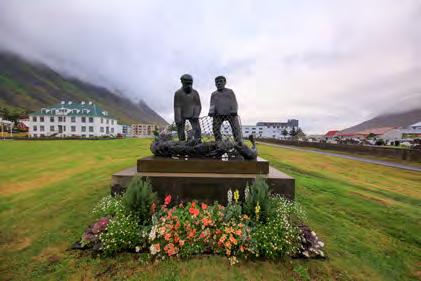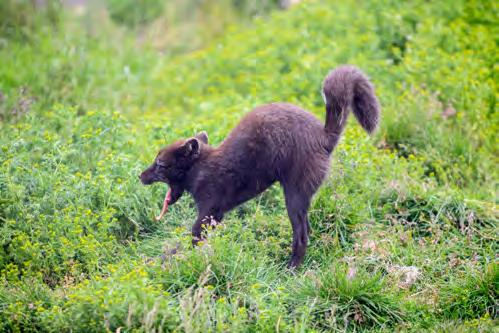
6 minute read
Horror, history and hikers’ paradise
A day in Hesteyri
Visiting the village at the edge of the world.
TEXT: Lisa Gail Shannen PHOTOS: Roman Gerasymenko
“I was conceived in this boat”, our young guide Villi cheerfully informs us in a strong, endearing Icelandic accent as he nods towards the Scorpion dinghy we’re about to board. Hesteyri, an abandoned village on the remote Hornstrandir peninsula – the northernmost part of the Westfjords – is only accessible by boat. Since there’s no harbour, we’re carefully lowered one at a time from the larger passenger boat into the smaller vessel which ferries us a short distance to the floating dock by the shore.
It takes just over an hour to sail from Isafjordur to our destination – a trip that had already provided quite an adventure. Our motor-powered passenger boat, with enough room to accommodate around 30 people, had zoomed across the waves roosting spray, while ambitious puffins took turns racing alongside us. Whale watching wasn’t on the itinerary but when a pod of large humpbacks was spotted breaching in the distance, we made a little detour to get a better look. We also caught sight of a few dolphins which seemed to be enjoying
TRAVEL Westfjords
a thrilling ride on the bow waves generated by our boat.
All the way, sheer, misty mountains in every direction provided spellbinding views while our hosts, Kiddy and Villi from Sjoferdir tours, took turns in both English and Icelandic to regale us with funny anecdotes, local folktales and lots of fascinating facts. The extensive Hornstrandir region was designated a nature reserve in 1975 and so it remains a true wilderness: free of grazing animals but home to countless species of birds, and, thanks to a hunting ban, the thriving domain of the elusive Arctic fox.
The village that time forgot
There were always a few farmers and fishermen living out in Hesteyri, ever since the time of settlement, but it wasn’t until the Norwegians built the whaling station together with some dwellings for workers that the area became a true community. After the whaling ban in 1915, the station was closed, but it reopened later as a herring factory. For as long as the herring lasted, the village prospered, and at one point there were 80 people living in Hesteyri. When the herring stocks

01


02 03

dwindled in the 1940s, so did the residents, and by 1952, with no reason left to endure the harsh winters and isolation, everyone moved away.
Literary landmarks
It’s a midsummer’s day when we alight on the beach in Hesteyri. While the village remains deserted throughout the winter, come summertime it springs to life, positively bursting with colour. The remaining 10 or so houses dotting the grassy banks directly above the shoreline are in varying stages of both dilapidation and renovation, with painters busy at work on a few of them.
Those of us (at least half our party) who’ve read I Remember You, Yrsa Sigurdardottir’s terrifying tale set in this very village, are already looking around to see if we can locate the real-life, three-dimensional versions of the historic locations she so vividly described on the page. Villi seems to sense our spirit of enquiry, and before anyone even asks he has pointed out all the literary landmarks, including the Doctor’s House (which now operates as a hostel and café during the summer), the graveyard, and the ruins of
the old whaling station, which the Icelandic Coast Guard once used as target practice. If you hike the 3 km (1.9 mi) northeast of the village you can see the perfect hole made by a clean shot right through the middle of the chimney.
DID YOU KNOW...
Air Iceland Connect flies to 17 destinations, which equals the number of inhabited islands of the Faroe Islands archipelago? They are 18 in total.
The “stolen” church
With just three hours to explore, we follow a leafy trail through a fragrant forest of wild angelica and up the slope of foothills behind the village. After a quick stop to take in the fabulous view, we head south towards the churchyard, which seems to be missing its church. It had been gifted to the people of Hesteyri by the Brodrene Bull whaling company, but when the settlement was abandoned the church was relocated by the Bishop of Iceland to the village of Sudavik, where it still stands today.
Since the building didn’t belong to the National Church and the former residents were never asked, they were all rather aggrieved and some still look upon the whole affair as robbery. The only remnant we can
04

01 One of the old houses in Hesteyri.
02 Fishermen’s memorial in Isafjordur.
03 Arctic fox at the Arctic Fox Centre in Sudavik.

04 A lunch of smoked salmon, pancakes and a slice of marriage cake at the Doctor’s House in Hesteyri.
05 Bell from the “stolen” church in Hesteyri.
06 Inside the Doctor’s House in Hesteyri.
05
06

see of the church now is the bell; proudly enshrined in a stone monument.
The Doctor’s House
After a pleasant walk around the beach, where some of us just couldn’t resist the urge to collect a few seashells (fans of Yrsa’s book will know why), we make a beeline for the Doctor’s House. We are greeted by cheery staff hanging out the washing and filling up a wheelbarrow with cans of beer to chill in the nearby stream. There’s to be a party later on and the overnight guests, mainly trekkers who are using the house as a base to explore the wonders of the Hornstrandir Nature Reserve, are all in good spirits. We’re treated to coffee and a light lunch of smoked salmon on rye bread with pancakes and a humble slice of traditional Icelandic hjonabandssaela (“wedded bliss”). The small dining area is crowded with people all enthusiastically engaged in conversations either about hiking trips to the famous Hornbjarg – a sea cliff on the northern tip of Hornstrandir, Yrsa’s scary book, or the fascinating history of Hesteyri.
In this setting, surrounded by activity and holiday excitement, it’s hard to imagine Hesteyri as the setting for a horror story. As terrifying as the book was, not even my solitary hike to the ruins of the whaling station fazed me. It’s hard to be afraid when you’re rambling on a lovely trail, with a face full of fresh air, navigating weather-beaten driftwood logs over shallow babbling brooks and surrounded by dazzling beauty. It’s just too much of an adventure.
Seasonal adventures:
Isafjordur provides a great base for exploring the Westfjords.
In summer, apart from the Hesteyri day tour, highlights include Paradise Island (Vigur), the famous Hornbjarg cliff, Bolafjall mountain in Bolungarvik, and Sudavik, where you’ll find both the Arctic Fox Centre and the “stolen” church from Hesteyri. Kayaking on the calm waters around Isafjordur is possible year-round. In winter, the northern lights return and visitors can go skiing at the local resorts or on thrilling off-piste ski expeditions to the Hornstrandir Nature Reserve.
Check out day tours at airicelandconnect.com/tours
Getting there:
Hesteyri
Isafjordur
Keflavik Reykjavik
Air Iceland Connect offers daily flights from Reykjavik to Isafjordur. Guided tours to Hesteyri are available from early June to late August. Private tours can also be arranged. airicelandconnect.com westfjords.is










